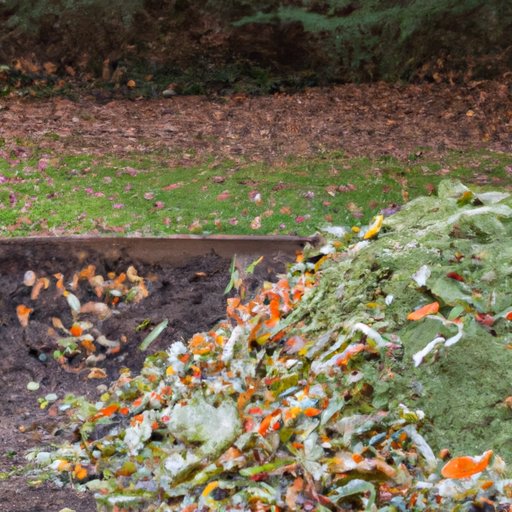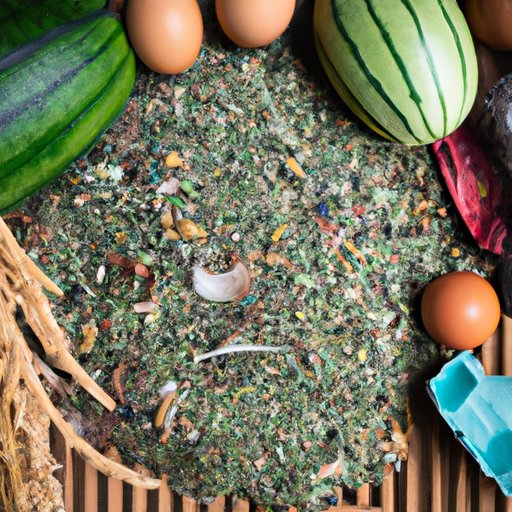
I. Introduction
Composting is an eco-friendly and cost-effective way to reduce waste while nourishing your garden. This article is aimed at beginners who are interested in starting their compost pile but aren’t sure where to begin.
II. Benefits of Composting: A Beginner’s Guide
Composting offers many benefits to the environment, your garden, and your household. By composting, you can reduce waste that would otherwise end up in landfills and promote sustainable gardening practices.
Benefits of Composting for the Environment
The environmental benefits of composting include reducing greenhouse gas emissions and conserving landfill space. Composting is an essential part of sustainable waste management and is a simple step towards reducing your carbon footprint.
Benefits of Composting for Your Garden
Composting supplies your garden with natural, nutrient-rich fertilizer while promoting healthy soil and a flourishing ecosystem. When you add compost to your soil, you enhance the soil’s water-retaining capacity and drainage, promoting healthy plant growth.
Benefits of Composting for Reducing Kitchen Waste
Composting is an effective way to reduce kitchen waste by up to 30%. Composting helps to reduce the amount of food waste that goes into landfills, where it produces greenhouse gases as it decomposes. By composting, you can turn your kitchen scraps into a valuable resource for your garden.
III. How to Start Composting in Your Backyard
If you’re ready to start composting, the first step is to choose the composting method that works best for you. There are several options to choose from, and you can use any of these to start your compost pile:
- Compost bin
- Trench composting
- Indoor composting with worms
- Composting with black soldier flies
Preparing a Compost Bin Location
Once you’ve decided which composting method you’ll use, you’ll need to find the location for your compost bin. Choose a spot that drains well and that is convenient for you. It’s best to place your compost bin in a shady spot.
Building or Purchasing a Compost Bin
If you choose to use a compost bin, you can make your own or buy one ready-made. If you opt to make a DIY compost bin, you can use materials you already have around the house, or you can buy a compost bin kit online or at a local garden center.
Adding Compostable Materials to Your Compost Bin
After setting up your bin, you can begin adding compostable materials. You can add fruit and vegetable scraps, coffee grounds, eggshells, yard waste, and more. Be sure to avoid adding meat, dairy, oil, and pet waste, as these can attract rodents and create unpleasant odors.
IV. Tips for Creating a Successful Compost Pile at Home
Creating a successful compost pile requires balancing carbon and nitrogen, choosing the right materials, keeping the compost moist, turning it regularly, and monitoring its progress.
Balancing Carbon and Nitrogen
The ideal carbon-to-nitrogen ratio in your compost pile is 30:1. Carbon-rich materials, like leaves and paper, provide energy for microorganisms while nitrogen-rich materials, like grass clippings and food waste, supply protein.
Choosing the Right Materials to Compost
When you’re deciding what to compost, keep in mind that the more varied your compost materials, the more nutrient-rich your compost will be. Some materials that you can add to your compost pile include vegetable scraps, leaves, plant trimmings, and coffee grounds, to name a few.
Keeping Compost Moist
For successful composting, your compost pile needs to be kept moist but not too wet. It’s best to aim for a moisture content of around 40 to 60%. You can check the moisture level by sticking your hand in the compost pile. If it feels slightly damp, then the moisture is just right.
Turning Compost Regularly
To help your compost pile decompose evenly, it’s important to turn it regularly. Turning your compost every two to four weeks will ensure air circulation and even decomposition.
Monitoring Your Compost Pile
Monitoring your compost pile is essential to ensure it’s decomposing correctly. Your compost should start to heat up and produce steam in its early stages, which is an indication that the microorganisms in your compost are working. After a few weeks, the pile should start to cool, which is an indication that the first stage of decomposition is complete.

V. The Science Behind Composting and How it Works
Composting can seem complex, but it’s actually relatively straightforward once you understand the underlying biology. Composting relies on microorganisms, like bacteria and fungi, to decompose organic matter. The decomposition process produces heat and carbon dioxide, which is what causes your compost pile to heat up.
Explanation of the Different Stages of Composting
There are three different stages in the composting process:
- The thermophilic phase
- The mesophilic phase
- The maturation phase
Explanation of the Chemistry of Composting
Composting is essentially a chemical process that converts complex organic matter into simpler organic matter. Composting relies on bacteria to break down sugars and starches into simpler molecules, like carbon dioxide and cellulose.
VI. Composting for a More Sustainable Lifestyle
Composting is a great way to reduce your impact on the environment while promoting a more sustainable lifestyle. Composting could help to reduce up to 30% of your household waste by turning kitchen scraps, yard waste, and other organic material into a valuable resource for your garden.
Explanation of How Composting Reduces Waste
Composting reduces waste by converting organic material that might otherwise end up in a landfill into a nutrient-rich soil amendment. This creates a closed-loop system, where waste is transformed into something valuable, rather than discarded.
Explanation of How Composting Can Reduce Greenhouse Gas Emissions
Landfills are a source of greenhouse gases, mainly methane and carbon dioxide, which contribute to climate change. By composting organic material, you’re reducing the amount of waste that goes to the landfill and cutting down on greenhouse gas emissions.
Explanation of How Composting Can Aid Your Garden and the Wider Ecosystem
Composting helps to improve your garden by providing natural nutrients and improving soil health. Additionally, composting helps to promote healthy plant growth, which benefits the wider ecosystem by providing homes and food sources for local wildlife.
VII. Simple Steps to Reduce Waste and Start Composting
Starting to compost is a simple process that can save you money and reduce waste. Here are a few tips to help you reduce your waste and start composting:
- Collect compostable material in a separate container
- Avoid contamination of different types of compostable materials by keeping meat, dairy, oil, and pet waste out of your compost
- Educate yourself and your family about composting and its benefits
VIII. Using Compost to Improve Your Garden and Reduce Your Carbon Footprint
Composting yields a nutrient-rich soil amendment that can be used in your garden, reducing your need for chemical fertilizers. By using compost instead, you’re reducing your carbon footprint and promoting a more sustainable gardening practice.
Explanation of the Benefits of Using Compost in Gardening
Compost helps to improve soil structure and fertility, reducing the need for chemical fertilizers and pesticides. Additionally, compost helps to retain moisture in the soil, promoting healthy plant growth, and acting as a natural weed suppressant.
Explanation of How Using Compost Can Reduce Your Carbon Footprint
By using compost instead of chemical fertilizers, you’re reducing the carbon footprint associated with creating, packaging, and shipping those fertilizers. Additionally, compost helps to sequester carbon in the soil, further reducing your carbon footprint.
IX. Conclusion
Composting is a valuable tool for any gardener or environmentally conscious individual. It’s a cost-effective and sustainable way to reduce waste while promoting healthy soil and plant growth. By following the tips and information outlined in this article, you can start your compost pile today and enjoy the benefits for years to come.





